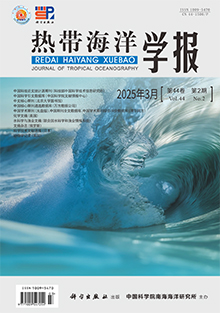Porites lutea, the representative species of reef building corals around the Hainan Island, is a spawning, massive coral with strong environmental adaptability. Exploring the genetic structure and connectivity of this species helps to reveal the genetic diversity pattern and larval migration path of coral metapopulation around the Hainan Island, thus clarifying the recovery potential of coral reefs. In this study, 11 P. lutea microsatellite markers were screened to analyze the genetic structure of 10 populations of the Hainan fringing reefs and 1 population (XsR) in the Xisha Islands. The results showed that, overall the genetic diversity of all populations was medium to low, with the average allelic richness Rs ranging from 2.8 ± 1.3 (Basuo population, Bs) to 3.7 ± 1.7 (Linchang Reef population, LcR), and the average observed and expected heterozygosity ranged from 0.31 (Tongguling population, Tgl) to 0.54 (Dachan Reef population, DcR) and 0.50 (Leigong Island population, LgI) to 0.64 (Haiwei population, Hw), respectively. Except for the Longwan Reef population (LwR) and the Dazhou Island population (DzI), which located in the east of the Hainan Island, and the Basuo population (Bs) and the Dachan Reef population DcR (in the west of Hainan Island), all other populations (7/11) showed evidence of heterozygote deficiency. According to genetic differentiation, the Hainan Island populations were divided into two groups: the north-south-east genetically connected zone and the west coast, and the differentiation between the two branches (AMOVA, 0.092) was significant. The former group included Bs, Luhuitou population (Lht), DzI, LgI and Mulantou population (Mlt), due to the significant gene flow created by exchange of ocean currents, there was no obvious genetic differentiation among these five coastal populations, whereas the gene flow of the offshore populations (LcR, DcR and Hw) of the west coast was blocked due to the discontinuity of coastal reefs and slow coastal currents. LwR in the east coast also converges to the west branch, which may be due to the isolation by environment and the convergent adaptation to offshore environment. Although the distance between Hw and Bs is less than 50 km, but they are obviously differentiated, possibly due to the isolation by salinity fluctuation and suspended sediments caused by the runoff of the Changhua River. Tgl showed strong inbreeding, low heterozygosity and non-random mating characteristics because it was located in the wave shadow area of the Tongguling headland, and the runoff of the Bamen River restricted its gene exchange with other coastal reef populations. Represented by P. lutea metapopulations, the fringing reefs of the Hainan Island has the natural resilience responding to environmental stress due to the strong gene flow and the genetic differentiation caused by ocean current, runoff and complex fringing reef structure, as well as the environmental differences between nearshore and offshore. The genetic differentiation between the Xisha Islands population and the coastal reef populations of the Hainan Island was large, showing significant geographical isolation. The Qilianyu Island may have lost the ability to replenish the Hainan Island with coral larvae because the coral reefs have declined there.




